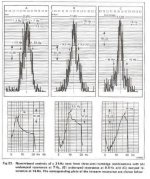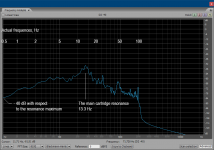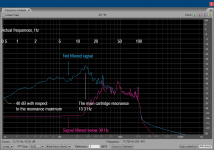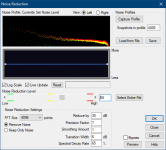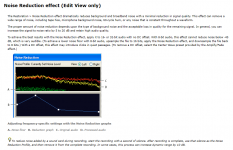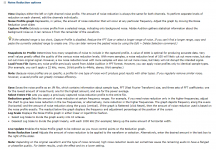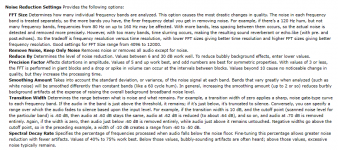I think by definition a hobby is a waste of time (and money). Why begrudge someone their hobby?What a huge waist of time. If you dont like the vinyl distortions, and dont forget the distortions from manufacturing, the lathe, worn stampers, etc,etc, buy the CD.
If the disk warp excites tonearm resonance frequency. You can't track the LP at all. It means you can't even make a digital copy of the LP. Once you are able to make a digital copy of the LP. The arm/cartridge resonance frequency is not a problem at all. In your digital copy of the LP, you cut all the information under 30 Hz out. In fact, you are not cutting out the excited arm/cartridge resonance frequency caused by warps.
Disagree. As has been shown on here, a silent groove will excite the arm/cartridge resonant frequency. A warp will make it bigger, and for a poorly matched combination cause a mighty tank slapper that could cause mistracking, but its not a given. I've been re-examining the analyses RayK did a couple of years ago on FM scrubbing, which is fascinating. We can agree that warps are bad though
Attached is a plot from the B&K paper showing the FM caused by different arm/cart resonant frequencies. They did cheat in one case by adding damping but it gives an idea of how much FM there can be adding to the sound (in a way that might indeed be pleasant).
On my todo list is to look at using a mastering elliptical EQ (EEQ) on playback. The EEQ basically folds the LF to mono to make the record both cuttable and playable. So in theory any vertical information below around 150Hz shouldn't be there. Removing it will change things about the soundstage. For better? I don't know yet...
Oh and here is the link requested earlier to attempts to correct pitch variation. Turntable speed stabilty
Attachments
Member
Joined 2019
It is remarkable how quickly and widely a misunderstanding may propagate..
It is one thing to say that in the case of 331/3 LP eccentricity, any audible frequency will change periodically, with a period of 1.8 s or a "frequency" of 0.555 Hz. In this case 'frequency' is another way to say that something is repeated "tat" frequently.
It is quite another think to declare that there exists some audible sound of 0.555 Hz. It does not exist or it is extremely low. And it is inaudible, as all the frequencies below 20 Hz.
I have prepared a frequency analysis of the actual sound of an unmodulated groove of my measuring record. The analyzed region is 0.5 Hz - 100 Hz. To go so low I use a trivial trick which may be familiar to some people. Anyway, I may explain it later.
We can see that in the region of 0.5 Hz the signal is down by 40 dB with respect to the 13.3 Hz resonance maximum.
It is one thing to say that in the case of 331/3 LP eccentricity, any audible frequency will change periodically, with a period of 1.8 s or a "frequency" of 0.555 Hz. In this case 'frequency' is another way to say that something is repeated "tat" frequently.
It is quite another think to declare that there exists some audible sound of 0.555 Hz. It does not exist or it is extremely low. And it is inaudible, as all the frequencies below 20 Hz.
I have prepared a frequency analysis of the actual sound of an unmodulated groove of my measuring record. The analyzed region is 0.5 Hz - 100 Hz. To go so low I use a trivial trick which may be familiar to some people. Anyway, I may explain it later.
We can see that in the region of 0.5 Hz the signal is down by 40 dB with respect to the 13.3 Hz resonance maximum.
Attachments
You are missing the point. The 0.55Hz modulates the rest of the signal. That can been seen on all the data I have presented. It is less audible than 4-10Hz modulation, but the level is much higher as can be very clearly seen in the 'grass' on the B&K plots close in to the fundamental.
I think you are considering pure tones at .55Hz. That is not what we are trying to explain.
I think you are considering pure tones at .55Hz. That is not what we are trying to explain.
I think you are considering pure tones at .55Hz. That is not what we are trying to explain.
I guess it's a problem of what they call organizational learning, every few months it just starts over from 0, kind of like Sisyphus. I'm seriously thinking of giving up.
Member
Joined 2019
I guess it's a problem of what they call organizational learning, every few months it just starts over from 0, kind of like Sisyphus. I'm seriously thinking of giving up.
The search function on here doesn't help. Took me a good 10 minutes to find Pano's analysis and I knew what I was looking for! I think we are close to having enough information spread about for a first pass on a decent wiki on '21st century vinyl replay'. After all Self filled 764 pages and not even sure he has a turntable any more
What a huge waist of time. If you dont like the vinyl distortions, and dont forget the distortions from manufacturing, the lathe, worn stampers, etc,etc, buy the CD.
The amazing thing about vinyl is that it just sounds so damn good. And, you get to tweak your setup and optimize it. Can’t do that with CD or digital.
Play a good vinyl alongside a CD recording of the same piece (assuming good gear) and you’ll soon discover the vinyl gives absolutely nothing away - I’d say in many cases it sounds better than digital.
Member
Joined 2019
Yes, I know what is FM... 

What I expect to see if I play the standard 3150 Hz signal in an eccentric record is something like
sin[ω (1+0.002sin(φt)) t] (A)
where ω = 2π * 3150, φ = 2π * 0.555 and 0.002 is the 0.2% eccentricity.
I am not interested in the extent of the 0.55 Hz component in the Fourier transformation of (A), but in the level of this component in the cartridge output.
What I expect to see if I play the standard 3150 Hz signal in an eccentric record is something like
sin[ω (1+0.002sin(φt)) t] (A)
where ω = 2π * 3150, φ = 2π * 0.555 and 0.002 is the 0.2% eccentricity.
I am not interested in the extent of the 0.55 Hz component in the Fourier transformation of (A), but in the level of this component in the cartridge output.
Last edited:
In which case I must ask WHY are you not interested in the modulation of the wanted signal by the record eccentricity? If you have decided that it's less audible than an 8Hz arm/cartridge resonance that is fine. There is a member on here who does have a Nakamichi TX-1000 and he swears by its effectiveness on off centre records.
The amazing thing about vinyl is that it just sounds so damn good. And, you get to tweak your setup and optimize it. Can’t do that with CD or digital.
Play a good vinyl alongside a CD recording of the same piece (assuming good gear) and you’ll soon discover the vinyl gives absolutely nothing away - I’d say in many cases it sounds better than digital.
If they were identicaly mastered I doubt it. And it definitly gives noise away for free, not to mention ticks and pops, microphonics etc,etc.
Member
Joined 2019
In which case I must ask WHY are you not interested in the modulation of the wanted signal by the record eccentricity?
I had a net problem, this is the reason of my delay.
I am interested in this and I have posted a clip in YouTube describing the surgery measures that I apply in some cases to reduce the record eccentricity to a level of 0.1% or lower. But the whole talk started from the question about the level of the 0.55 Hz component in the cartridge signal. I posted just before a frequency spectrum where this component is not looking as a peak at all and, in any case, is lower by 40 dB with regard to the resonance frequency level. I really do not understand what else should I do..
It is quite late here. I hope we may continue tomorrow.
Last edited:
If they were identicaly mastered I doubt it. And it definitly gives noise away for free, not to mention ticks and pops, microphonics etc,etc.
Not if the vinyl is in good condition. As for noise, you don’t hear it when the music is playing. Typical dynamic range on an LP is 60 dB and a CD about 90+ dB. However, on recorded material it’s probably only about 20 dB in real terms.
Anyway, if you don’t like vinyl, why not head over to the digital forum and stop trolling here?
But the whole talk started from the question about the level of the 0.55 Hz component in the cartridge signal. I posted just before a frequency spectrum where this component is not looking as a peak at all and, in any case, is lower by 40 dB with regard to the resonance frequency level. I really do not understand what else should I do..
It is quite late here. I hope we may continue tomorrow.
Ok that was my fault for rushing out an intial answer during my break rather than waiting until I had time. The plots I showed (and thread now linked to on that) show the effective level of the modulation that subsonics give. Look at the B&K image and you can see as you get closer to the fundamental the higher the level goes. I don't want to go into where to place the arm cart resonance as there are other threads on that and I'll just say that I am of the view that >10Hz is good. There are things you can do to reduce the effect of the arm/cart resonance but you can't completely remove it (although Townshend with their rock turntables did claim that). My point on the eccentricity is that it's a potential quick win for removing an audible artifact and all efforts should be made to reduce it.
I'll dig out some links to other threads that have a lot of useful stuff in around this so you can see where we are coming from and so we can leave the known stuff and see if there are new things to be discussed (which there will be)
Disagree. As has been shown on here, a silent groove will excite the arm/cartridge resonant frequency. A warp will make it bigger, and for a poorly matched combination cause a mighty tank slapper that could cause mistracking, but its not a given. I've been re-examining the analyses RayK did a couple of years ago on FM scrubbing, which is fascinating. We can agree that warps are bad though
I don’t disagree with you. However, you have to see he edited the rips in a digital format. So, we have two possible cases here.
1. Warp frequency is adjacent to arm/cartridge frequency. But it just adds on the arm/cartridge frequency. It doesn’t cause mistracking
In this case, an increased level of arm/cartridge resonance is just low-frequency information in the digital domain. It will not cause any mistracking of a laser head of a CD player or other digital signal reader. If someone insists to cut all this information out, it is a purely personal choice. After digital ripping, it has nothing to do with warps and arm/cartridge resonance frequency.
2. Arm/cartridge resonance frequency does cause mistracking. In his word, The disk warps, which activate tonearm resonance vibrations
In this case, arm/cartridge resonance frequency does cause mistracking. Such mistracking will have an effect on all frequency range, from 20 Hz-20 kHz. Even he can rip the LP with mistracking. Distortions will be ripped in digital format from 20 Hz-20 kHz, too. But he only cut all the information under 30 Hz. Therefore, IT IS USELESS.
Finally, his editing has nothing to do with warps and arm/cartridge resonance frequency. He just edits some low-frequency information out in the digital domain. I think it is unnecessary and useless.
Last edited:
Member
Joined 2019
Two more pictures related to my recent measurement of the non-modulated groove noise. The signal is restricted to 100 Hz for better clarity.
The first one shows the effect of the FFT filtering below 30 Hz. The signal level at the resonance frequency of 13.3 Hz is reduced by nearly 60 dB.
The second picture shows a part of the waveform of the measured signal with no filtering and with FFT filtering below 30 Hz. In the unfiltered waveform one can clearly see the component of the resonance frequency of 13.3 Hz.
And some words about the trick used to analyze frequencies down to 0.5 Hz. Those familiar with the Frequency Analysis tool of Adobe Audition know, that this analysis goes down to 10 Hz only. To analyze below this frequency:
1. I record a quite long sample of the analyzed material, say 2-3 min.
2. I use the "Stretch" tool to get a copy of the signal with all frequencies multiplied by 20.
3. I analyze the stretched copy.
This is why the actual frequency of 100 Hz is seen in the analysis as frequency 2000 Hz.
The first one shows the effect of the FFT filtering below 30 Hz. The signal level at the resonance frequency of 13.3 Hz is reduced by nearly 60 dB.
The second picture shows a part of the waveform of the measured signal with no filtering and with FFT filtering below 30 Hz. In the unfiltered waveform one can clearly see the component of the resonance frequency of 13.3 Hz.
And some words about the trick used to analyze frequencies down to 0.5 Hz. Those familiar with the Frequency Analysis tool of Adobe Audition know, that this analysis goes down to 10 Hz only. To analyze below this frequency:
1. I record a quite long sample of the analyzed material, say 2-3 min.
2. I use the "Stretch" tool to get a copy of the signal with all frequencies multiplied by 20.
3. I analyze the stretched copy.
This is why the actual frequency of 100 Hz is seen in the analysis as frequency 2000 Hz.
Attachments
Last edited:
Member
Joined 2019
Noise reduction
Noise reduction (NR) is the most discussed and questioned part of the digital editing procedure. The main source of the noise are the irregularities in the grooves surface, which start from a given production level and increase with the use of the record. But we may have also some noise present in the original "master" material, especially in the case of quite old master recordings and/or master disks of 75 rpm recorded to the newer LP format. In this case some purist may call NR "a partial violation of the original material".
In my case the noise spectrum starts from 30 (or 25 or 20) Hz, as long as the FFT rejection of very low frequencies precedes NR. The intensity of the noise typically decreases with the increase of the frequency. In most cases the total unweighted RMS value of the noise is about -50 dB, but there are cases of very high disk quality where the noise RMS approaches -60 dB.
The NR procedure I use is based on a selected sample with no groove modulation. This may be taken from the initial part of the disk or from some pause between different record parts. As the disk noise has usually a periodical component, it is good to select sample of duration multiples of 1.8 sec (for 331/3 rpm). 1.8 sec works well, but I select samples of 3.6 sec or 5.4 sec, when available. In Adobe Audition this initial part of the NR procedure is called "Capturing Noise Reduction Profile".
The second part is the Noise Reduction process, which uses the captured noise profile to substract it, by use of Fourier transform, from the material under de-noising. This tool has a large number of adustable parameters, the most important of which is the Noise Reduction Level. The Help support of Audition provides very detailed instructions, but one has to experiment in order to achieve a satisfactory result. Once achieved, a good set of denoising parameters may serve in a lot of different cases. I attach a picture of the Audition noise reduction tool and also a dump of the Help instructions.
Selecting a good noise reduction level is a matter of experience, but also of taste. Some prefer to apply lower reduction level, in order to be 'on the safer side'. In these cases some noise is still audible, but not too annoying. Other prefer higher values, in order to have not audible levels of noise at moderate listening sound levels. I am closer to the second type, but make it in a more mild way, by use of a transition width of 6 dB. This means that the de-noising below the selected level Ln is not applied fully, but gradually, starting from 0% at Ln and ending to 100% at Ln-6 dB and lower.
I think that all said here + the Adobe Audition help materials give a good idea of the subject.
Noise reduction (NR) is the most discussed and questioned part of the digital editing procedure. The main source of the noise are the irregularities in the grooves surface, which start from a given production level and increase with the use of the record. But we may have also some noise present in the original "master" material, especially in the case of quite old master recordings and/or master disks of 75 rpm recorded to the newer LP format. In this case some purist may call NR "a partial violation of the original material".
In my case the noise spectrum starts from 30 (or 25 or 20) Hz, as long as the FFT rejection of very low frequencies precedes NR. The intensity of the noise typically decreases with the increase of the frequency. In most cases the total unweighted RMS value of the noise is about -50 dB, but there are cases of very high disk quality where the noise RMS approaches -60 dB.
The NR procedure I use is based on a selected sample with no groove modulation. This may be taken from the initial part of the disk or from some pause between different record parts. As the disk noise has usually a periodical component, it is good to select sample of duration multiples of 1.8 sec (for 331/3 rpm). 1.8 sec works well, but I select samples of 3.6 sec or 5.4 sec, when available. In Adobe Audition this initial part of the NR procedure is called "Capturing Noise Reduction Profile".
The second part is the Noise Reduction process, which uses the captured noise profile to substract it, by use of Fourier transform, from the material under de-noising. This tool has a large number of adustable parameters, the most important of which is the Noise Reduction Level. The Help support of Audition provides very detailed instructions, but one has to experiment in order to achieve a satisfactory result. Once achieved, a good set of denoising parameters may serve in a lot of different cases. I attach a picture of the Audition noise reduction tool and also a dump of the Help instructions.
Selecting a good noise reduction level is a matter of experience, but also of taste. Some prefer to apply lower reduction level, in order to be 'on the safer side'. In these cases some noise is still audible, but not too annoying. Other prefer higher values, in order to have not audible levels of noise at moderate listening sound levels. I am closer to the second type, but make it in a more mild way, by use of a transition width of 6 dB. This means that the de-noising below the selected level Ln is not applied fully, but gradually, starting from 0% at Ln and ending to 100% at Ln-6 dB and lower.
I think that all said here + the Adobe Audition help materials give a good idea of the subject.
Attachments
Last edited:
Member
Joined 2019
One more test recording. The first track of a rare blues LP. I apologize to all forum lovers of rumble, clicks, pops, surface noise and channels dis-balance. I have removed them. As a enlightened American audio-professional said years ago (I don't remember his name): "nobody can forbid some people to like harmonic distortion". But equally, nobody can force me to like rumble, clicks, pops, surface noise and channels dis-balance. 
The Shakey Sam Blues Band
Balkanton ВТА 2100
Bulgaria, 1981
Living In The Country
The Shakey Sam Blues Band (2).flac - Google Drive
The Shakey Sam Blues Band
Balkanton ВТА 2100
Bulgaria, 1981
Living In The Country
The Shakey Sam Blues Band (2).flac - Google Drive
- Status
- This old topic is closed. If you want to reopen this topic, contact a moderator using the "Report Post" button.
- Home
- Source & Line
- Analogue Source
- Editing of digitized vinyl music - Pros and Cons
